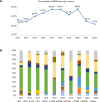Longitudinal surveillance of the molecular evolution of methicillin-resistant Staphylococcus aureus isolates from pediatric patients in Shanghai, China, from 2013 to 2022
- PMID: 40304507
- PMCID: PMC12090807
- DOI: 10.1128/msystems.00371-25
Longitudinal surveillance of the molecular evolution of methicillin-resistant Staphylococcus aureus isolates from pediatric patients in Shanghai, China, from 2013 to 2022
Abstract
The objective of this research was to investigate the genomic epidemiology of methicillin-resistant Staphylococcus aureus (MRSA) in a pediatric population in Shanghai, China. Whole-genome sequencing was conducted for 492 randomly selected MRSA isolates obtained from a pediatric hospital between 2013 and 2022. ST59 (37.4%), ST398 (22.4%), ST88 (5.7%), and ST22 (5.5%) were the predominant lineages among these children. While ST59 maintained a dominant annual proportion before 2017, the proportion of ST398 gradually increased from 2013 to 2016, with ST398 ultimately emerging as a prevalent clone with a proportion comparable to that of ST59 after 2017. Among the prevalent STs, the spa-SCCmec structure also experienced dynamic changes. Within ST59, the t437-IV subtype experienced a decline and has even been replaced by t172-IV in recent years. In ST398, the t011-V subtype appeared in 2014 and rapidly became the leading subtype. The antibiotic resistance profiles and virulence factors exhibited clone-related features. Compared with other prevalent lineages, ST59 presented high resistance to erythromycin and clindamycin, whereas ST398 presented relatively low resistance to common antimicrobial agents and fewer virulence determinants. Panton-Valentine leucocidin was more common in ST338 and ST1232, whereas toxic shock syndrome toxin was closely associated with ST1 and ST5. The MRSA cases could also be classified into community- and hospital-associated cases, with highly significant differences between the two in terms of demographic characteristics, clindamycin susceptibility, and virulence genes. In conclusion, this study revealed high genetic diversity and dynamic changes in the molecular epidemiology of pediatric MRSA isolates from Shanghai collected over a decade.
Importance: Methicillin-resistant Staphylococcus aureus (MRSA) has emerged as a significant global health concern. Previous research on MRSA epidemiology has predominantly focused on adult populations or targeted specific infection sites, while there was limited research on the long-term evolution of MRSA from the pediatric population. This study addresses this knowledge gap by conducting a comprehensive, 10-year surveillance of pediatric MRSA isolates using whole-genome sequencing. We characterized the molecular typing, as well as the phenotypic and genotypic antimicrobial resistance profiles, and virulence factors present in MRSA isolates obtained from children. Our results highlight the imperative for continuous, vigilant monitoring of MRSA within the pediatric demographic to track its evolving genetic landscape.
Keywords: antibiotics; children; genome sequencing; methicillin-resistant Staphylococcus aureus; molecular epidemiology.
Conflict of interest statement
The authors declare no conflict of interest.
Figures





Similar articles
-
Antimicrobial resistance and molecular characteristics of bovine mastitis-associated methicillin-resistant Staphylococcus aureus: potential for cross-species transmission of ST59-MRSA.Microbiol Spectr. 2025 Jul;13(7):e0280024. doi: 10.1128/spectrum.02800-24. Epub 2025 May 21. Microbiol Spectr. 2025. PMID: 40396723 Free PMC article.
-
Reshaping the battlefield: A decade of clonal wars among Staphylococcus aureus in China.Drug Resist Updat. 2025 Jan;78:101178. doi: 10.1016/j.drup.2024.101178. Epub 2024 Nov 29. Drug Resist Updat. 2025. PMID: 39626615
-
Whole genome sequencing and molecular epidemiology of methicillin-resistant Staphylococcus aureus isolated from patients with bacteraemia in Slovenia.Eur J Clin Microbiol Infect Dis. 2024 May;43(5):969-977. doi: 10.1007/s10096-024-04802-1. Epub 2024 Mar 22. Eur J Clin Microbiol Infect Dis. 2024. PMID: 38517572 Free PMC article.
-
Evolution of community- and healthcare-associated methicillin-resistant Staphylococcus aureus.Infect Genet Evol. 2014 Jan;21:563-74. doi: 10.1016/j.meegid.2013.04.030. Epub 2013 May 3. Infect Genet Evol. 2014. PMID: 23648426 Free PMC article. Review.
-
Trends in invasive methicillin-resistant Staphylococcus aureus infections.Pediatrics. 2013 Oct;132(4):e817-24. doi: 10.1542/peds.2013-1112. Epub 2013 Sep 23. Pediatrics. 2013. PMID: 24062373 Free PMC article. Review.
Cited by
-
Development and validation of a hierarchical machine learning method using MALDI-TOF mass spectrometry for rapid SCCmec typing and PVL detection in MRSA: a multi-centre study.Emerg Microbes Infect. 2025 Dec;14(1):2525264. doi: 10.1080/22221751.2025.2525264. Epub 2025 Jul 17. Emerg Microbes Infect. 2025. PMID: 40576568 Free PMC article.
References
-
- Algammal AM, Hetta HF, Elkelish A, Alkhalifah DHH, Hozzein WN, Batiha GE-S, El Nahhas N, Mabrok MA. 2020. Methicillin-resistant Staphylococcus aureus (MRSA): one health perspective approach to the bacterium epidemiology, virulence factors, antibiotic-resistance, and zoonotic impact. Infect Drug Resist 13:3255–3265. doi:10.2147/IDR.S272733 - DOI - PMC - PubMed
MeSH terms
Substances
Grants and funding
LinkOut - more resources
Full Text Sources
Medical
Miscellaneous
